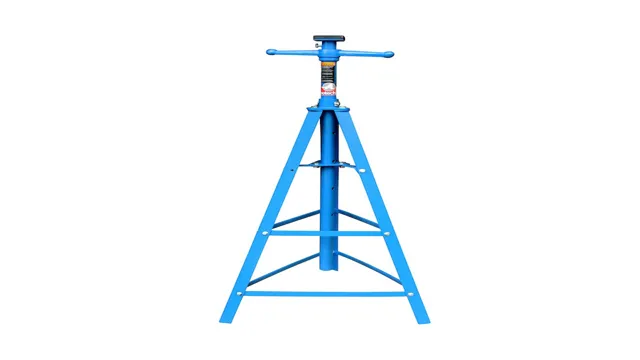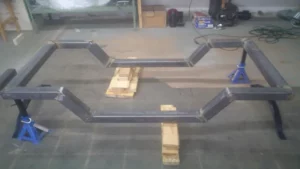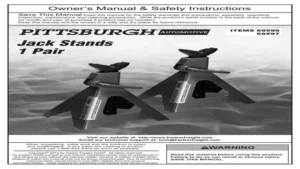Do you know how to properly position jack stands when you’re working on your vehicle? It’s crucial to get it right to ensure your safety and prevent accidents. Here’s the thing: Jack stands are used to support your vehicle when jacking it up, and they need to be positioned correctly to make sure that your car or truck remains stable during maintenance or repair work. In this blog post, we’ll show you how to position jack stands properly and give you some safety tips to keep in mind.
So sit tight, and let’s make sure you know what you’re doing when you’re working under your car.
Select an Even Surface
When positioning jack stands, it’s crucial to select an even surface to avoid any accidents or mishaps. An uneven surface may cause the jack stands to tip over, which is extremely dangerous and can result in severe injuries. Before positioning the jack stands, inspect the ground to ensure it’s level and smooth with no bumps or potholes.
If the surface is not even, consider using a flat board or a piece of plywood to provide a more stable foundation. It’s also essential to check the weight capacity of the jack stands to ensure they can withstand the weight of the vehicle. Remember, safety always comes first, and taking the time to select an even surface will prevent any unwanted accidents or damage to both the vehicle and the operator.
So, when positioning your jack stands, make sure to choose a leveled surface to avoid any mishaps or injuries.
Inspect Your Vehicle
When it comes to inspecting your vehicle, the first step is to find an even surface to park on. This is important because it allows you to get a better view of your vehicle and ensures that you can accurately check the different components. An uneven surface can make it difficult to see if there are issues with your tires or suspension system.
Additionally, parking on an incline can cause certain fluids to flow to one side, potentially giving you a false reading of the fluid levels. So, it’s important to always park on a level surface when inspecting your vehicle. Take the time to find a spot that’s safe and flat, and then you’ll be ready to start examining your car.
Looking over your car periodically can help you catch issues before they become major problems, saving you time, money, and inconvenience.

Check the Capacity of the Jack Stand
When it comes to using jack stands, it’s important to make sure they have the capacity to support the weight of your vehicle. The last thing you want is for the jack stand to fail and your car comes crashing down. So, before you even begin to jack up your car, make sure you check the jack stand’s capacity rating.
This information can typically be found on the label or in the owner’s manual. It’s crucial to select a jack stand with the appropriate capacity for your vehicle, as using one that’s too weak can be extremely dangerous. Always err on the side of caution and choose a jack stand with a high enough weight rating.
Additionally, make sure to select an even surface when using jack stands. Uneven surfaces can cause the jack stands to wobble or even tip over, leading to disastrous consequences. The last thing you want is to be underneath your car when it collapses due to unstable jack stands.
Be sure to choose a flat, level surface before using your jack stands.
Lift the Vehicle with a Floor Jack
When it comes to working underneath your vehicle, jack stands are essential to your safety. Before you can position the jack stands, you must first lift the vehicle with a floor jack. Start by parking on a level surface and engaging the parking brake.
Jack up the vehicle by placing the jack under a designated jacking point. Once the vehicle is lifted, you can locate the appropriate areas to place the jack stands. These locations may vary, but they are typically indicated in your vehicle’s owner’s manual.
As a general rule, place the jack stands on either side of the vehicle’s frame to evenly distribute the weight. Always double-check that the jack stands are locked securely in place before working underneath your vehicle. By taking the necessary precautions and properly positioning your jack stands, you can ensure your safety while working on your vehicle.
Identify the Correct Jack Point
Before you lift your vehicle with a floor jack, it’s critical to identify the correct jack point. The jack point is the secure location on your vehicle where the jack stands are placed. Usually, the owner’s manual would provide a map of the lift points, but you can examine the car’s undercarriage to find them.
Generally, the jack points on most cars are situated within the sturdy frame of the vehicle. Avoid lifting the car from any other spot as this might cause harm or damage. Lifting the car from the incorrect jack point might cause the car to tip and slide off the jackstand.
Therefore, it’s essential to identify the correct one. If you’re unsure about the procedure, seek assistance from a professional to prevent accidents and harm. Remember, safety is always a top priority when it comes to lifting your vehicle with a floor jack.
Raise the Vehicle
If you’re looking to perform maintenance on your vehicle or simply need to swap out a flat tire, raising the vehicle is an essential step. Doing so will allow you to access the underside of the vehicle or remove and replace wheels with ease. One of the easiest ways to lift a vehicle is with a floor jack.
These jacks use hydraulic power to bring the car off the ground, and come in a variety of sizes to suit any vehicle. Before lifting the vehicle, make sure to find a level surface and chock the wheels to prevent them from rolling. Then, position the jack in the appropriate lifting point mentioned in your car’s manual, and pump the handle until the vehicle is lifted a few inches off the ground.
It’s essential to use the correct lifting points to avoid damaging the car or the jack. Always double-check that the vehicle is secure and won’t tip over before working on it. With a floor jack, lifting your vehicle is a simple task that’s crucial to performing any maintenance job effectively.
Place the Jack Stands
When it comes to working on your vehicle, safety should always be your top concern. One critical safety step is correctly positioning your jack stands. Typically, you’ll want to place them at the car’s jack points, which can usually be found in your vehicle owner’s manual.
However, if you can’t find these, look for the traditional pinch welds underneath the car, just behind the front wheel and ahead of the rear wheel. Once you locate these points, line up your jack stands beneath them, ensuring that they are securely in place before lowering your vehicle onto them. Remember, never work on your vehicle if it is unsupported by secure jack stands as this can be incredibly dangerous.
So, take the time to position them correctly and earn peace of mind knowing that your vehicle is stable and secure.
Choose the Correct Location
When it comes to safely raising your vehicle, choosing the correct location is key. Before placing the jack stands, make sure you are on a level surface, away from any potential hazards. Check the ground for stability and avoid soft or uneven areas.
It’s also important to check that the weight capacity of the jack stands matches the weight of your vehicle. Once you have found a suitable location, place the jack stands securely under the vehicle’s frame or designated lift points. Double-check that the stands are in the correct position and are stable before lowering the vehicle onto them.
Remember, safety should always be your number one priority when working on your car. Don’t rush the process and take your time to ensure everything is in place properly. By following these simple steps, you can confidently raise your vehicle and work on it knowing you have taken all the necessary precautions.
Position the Jack Stands
When it comes to working on your car, safety should always be your top priority. That’s why it’s important to know how to place jack stands properly. Firstly, park your car on a level surface and ensure the emergency brake is on, then jack up one side of the car using a floor jack.
Once the car is lifted, locate the manufacturer’s recommended jack points, or the reinforced areas of the frame. Position the jack stands on these points, making sure they are secure and level. Slowly lower your car onto the stands, double-checking that they are securely in place before starting any work.
Remember that a car can weigh thousands of pounds, so it’s critical to use jack stands that have the appropriate weight capacity. Taking these precautions will help ensure your safety while working on your vehicle.
Lower the Vehicle
If you’re interested in working on your vehicle, then you’ll need to know how to position jack stands correctly. When considered safety, the first step is to lower the vehicle to the ground as far as possible. This step is critical because the lower the car is, the easier it is to get under it and position jack stands.
Make sure to park your car on a flat surface and apply the parking brake to prevent it from rolling. Once you’ve loosened the lug nuts of your tires, use a jack to raise the car off the ground. Then place the jack stands at the recommended points and slowly lower the car onto them.
Finally, give the car a little shake to ensure it’s stable on the jack stands. Remember, always double-check the stability of your vehicle on the jack stands before doing any work underneath it. Now you know how to position jack stands correctly to ensure your safety while working on your vehicle.
Slowly Release the Floor Jack
Slowly Release the Floor Jack – Lower the Vehicle Now that the task of lifting your vehicle with a floor jack has been done, it’s time to start lowering it back down safely. This is achieved by slowly releasing the floor jack. Begin by grasping the handle of the jack and carefully turning the release valve counterclockwise.
This will allow the hydraulic fluid to flow back into the reservoir. A common mistake is to open the valve too abruptly, causing the vehicle to drop too quickly. Take your time, and lower the vehicle slowly.
Once the vehicle is back on the ground, tighten any lug nuts that may have become loose during the tire change. To ensure you lower the vehicle safely, it is vital to keep a firm grip on your floor jack’s handle while lowering the vehicle, ensuring that the vehicle stays in full control. Make sure to completely lower the vehicle off of the jack before disconnecting it and never leave your floor jack under the vehicle.
It’s essential to release the jack slowly, carefully, and methodically to avoid any potential mishaps. Remember, safety is always the most critical concern. By following these steps, you’ll have successfully lowered your vehicle without any complications.
It’s crucial never to rush through the process, as it can be dangerous and cause damage to your car. Take your time, remain calm, and follow the steps carefully. Slowly release the floor jack and lower the vehicle without rushing.
Remember, it’s better to be safe than sorry.
Additional Safety Precautions
Positioning jack stands is a crucial step in ensuring your safety when working under a vehicle. After you have jacked up your car, it is important to place the jack stands in the proper position. To do this, make sure that the stand is placed on a solid and level surface under the frame of the car.
Avoid placing the jack stand on the suspension or any other unstable spot, as it might slip or tip over. Make sure that the jack stand is firmly seated, and that there is no movement or wobbling. To ensure maximum stability, engage the parking brake and chock the wheels.
Always remember to double-check the positioning of your jack stands and never work alone. Taking the extra precautions during this essential step will help prevent any potential accidents or injuries.
Conclusion
In conclusion, positioning jack stands is like playing a game of Jenga – except the stakes are much higher and the consequences of a wrong move could mean serious injury or even death. So, take your time and carefully assess the aces for optimal stability. Remember, safety first always and ensure that your car is well-supported and secure before getting under it.
And, if all else fails, don’t be afraid to call in a professional – they’ll have your back (or your car’s back) without fail.”
FAQs
What are jack stands and why are they important for car maintenance?
Jack stands are a type of support device used to hold a vehicle in an elevated position during repairs or maintenance. They are necessary to ensure the safety of the person working on the car and prevent accidents from occurring.
Can you use just one jack stand to support a vehicle?
No, it is not recommended to use just one jack stand as it can lead to instability and cause the vehicle to tip over. Always use a pair of jack stands to ensure proper balance and stability.
How do you choose the right size and weight rating for jack stands?
The weight rating for jack stands should correspond to the weight of the vehicle you plan on lifting. The size of the jack stand should also be able to fit securely under the car’s lift points.
How do you position and place jack stands?
Make sure to place the jack stands on a level surface and position them close to the lift points specified in the vehicle’s manual. Never position them on an incline or on an unstable surface.
How do you safely lower a vehicle from jack stands?
Before lowering the vehicle, ensure that all tools and equipment are clear of the car, and the area is free of obstructions. Then, slowly and carefully use the jack to lower the vehicle until it’s back on the ground.
Can you use a jack stand on an asphalt surface?
Jack stands should only be used on a level and stable surface. If the asphalt surface is stable and level, then it should be safe to use a jack stand.
How often should you inspect your jack stands for wear and tear?
It is recommended to inspect your jack stands before every use to look for any visible signs of wear and tear. If they show signs of rust, cracks, or other damage, they should be replaced immediately.






